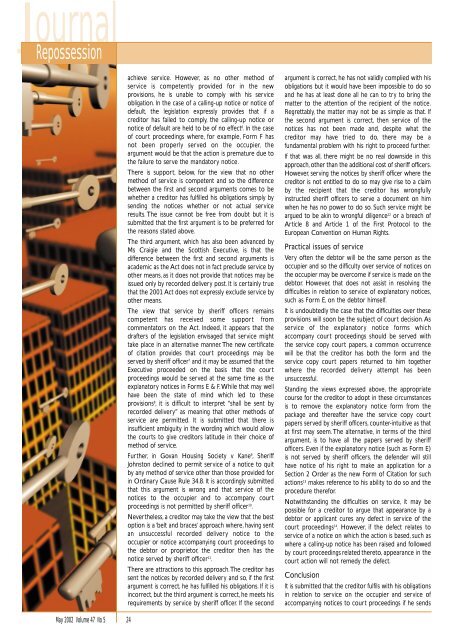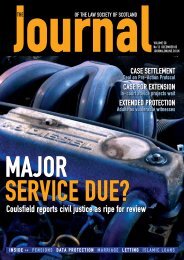OF THE LAW SOCIETY OF SCOTLAND - The Journal Online
OF THE LAW SOCIETY OF SCOTLAND - The Journal Online
OF THE LAW SOCIETY OF SCOTLAND - The Journal Online
You also want an ePaper? Increase the reach of your titles
YUMPU automatically turns print PDFs into web optimized ePapers that Google loves.
<strong>Journal</strong><br />
Repossession<br />
May 2002 Volume 47 No 5 24<br />
achieve service. However, as no other method of<br />
service is competently provided for in the new<br />
provisions, he is unable to comply with his service<br />
obligation. In the case of a calling-up notice or notice of<br />
default, the legislation expressly provides that if a<br />
creditor has failed to comply, the calling-up notice or<br />
notice of default are held to be of no effect6 . In the case<br />
of court proceedings where, for example, Form F has<br />
not been properly served on the occupier, the<br />
argument would be that the action is premature due to<br />
the failure to serve the mandatory notice.<br />
<strong>The</strong>re is support, below, for the view that no other<br />
method of service is competent and so the difference<br />
between the first and second arguments comes to be<br />
whether a creditor has fulfilled his obligations simply by<br />
sending the notices whether or not actual service<br />
results. <strong>The</strong> issue cannot be free from doubt but it is<br />
submitted that the first argument is to be preferred for<br />
the reasons stated above.<br />
<strong>The</strong> third argument, which has also been advanced by<br />
Ms Craigie and the Scottish Executive, is that the<br />
difference between the first and second arguments is<br />
academic as the Act does not in fact preclude service by<br />
other means, as it does not provide that notices may be<br />
issued only by recorded delivery post. It is certainly true<br />
that the 2001 Act does not expressly exclude service by<br />
other means.<br />
<strong>The</strong> view that service by sheriff officers remains<br />
competent has received some support from<br />
commentators on the Act. Indeed, it appears that the<br />
drafters of the legislation envisaged that service might<br />
take place in an alternative manner.<strong>The</strong> new certificate<br />
of citation provides that court proceedings may be<br />
served by sheriff officer7 and it may be assumed that the<br />
Executive proceeded on the basis that the court<br />
proceedings would be served at the same time as the<br />
explanatory notices in Forms E & F.While that may well<br />
have been the state of mind which led to these<br />
provisions8 , it is difficult to interpret “shall be sent by<br />
recorded delivery” as meaning that other methods of<br />
service are permitted. It is submitted that there is<br />
insufficient ambiguity in the wording which would allow<br />
the courts to give creditors latitude in their choice of<br />
method of service.<br />
Further, in Govan Housing Society v Kane9 , Sheriff<br />
Johnston declined to permit service of a notice to quit<br />
by any method of service other than those provided for<br />
in Ordinary Cause Rule 34.8. It is accordingly submitted<br />
that this argument is wrong and that service of the<br />
notices to the occupier and to accompany court<br />
proceedings is not permitted by sheriff officer10 .<br />
Nevertheless, a creditor may take the view that the best<br />
option is a ‘belt and braces’ approach where, having sent<br />
an unsuccessful recorded delivery notice to the<br />
occupier or notice accompanying court proceedings to<br />
the debtor or proprietor, the creditor then has the<br />
notice served by sheriff officer11 .<br />
<strong>The</strong>re are attractions to this approach.<strong>The</strong> creditor has<br />
sent the notices by recorded delivery and so, if the first<br />
argument is correct, he has fulfilled his obligations. If it is<br />
incorrect, but the third argument is correct, he meets his<br />
requirements by service by sheriff officer. If the second<br />
argument is correct, he has not validly complied with his<br />
obligations but it would have been impossible to do so<br />
and he has at least done all he can to try to bring the<br />
matter to the attention of the recipient of the notice.<br />
Regrettably, the matter may not be as simple as that. If<br />
the second argument is correct, then service of the<br />
notices has not been made and, despite what the<br />
creditor may have tried to do, there may be a<br />
fundamental problem with his right to proceed further.<br />
If that was all, there might be no real downside in this<br />
approach, other than the additional cost of sheriff officers.<br />
However, serving the notices by sheriff officer where the<br />
creditor is not entitled to do so may give rise to a claim<br />
by the recipient that the creditor has wrongfully<br />
instructed sheriff officers to serve a document on him<br />
when he has no power to do so. Such service might be<br />
argued to be akin to wrongful diligence12 or a breach of<br />
Article 8 and Article 1 of the First Protocol to the<br />
European Convention on Human Rights.<br />
Practical issues of service<br />
Very often the debtor will be the same person as the<br />
occupier and so the difficulty over service of notices on<br />
the occupier may be overcome if service is made on the<br />
debtor. However, that does not assist in resolving the<br />
difficulties in relation to service of explanatory notices,<br />
such as Form E, on the debtor himself.<br />
It is undoubtedly the case that the difficulties over these<br />
provisions will soon be the subject of court decision. As<br />
service of the explanatory notice forms which<br />
accompany court proceedings should be served with<br />
the service copy court papers, a common occurrence<br />
will be that the creditor has both the form and the<br />
service copy court papers returned to him together<br />
where the recorded delivery attempt has been<br />
unsuccessful.<br />
Standing the views expressed above, the appropriate<br />
course for the creditor to adopt in these circumstances<br />
is to remove the explanatory notice form from the<br />
package and thereafter have the service copy court<br />
papers served by sheriff officers, counter-intuitive as that<br />
at first may seem. <strong>The</strong> alternative, in terms of the third<br />
argument, is to have all the papers served by sheriff<br />
officers. Even if the explanatory notice (such as Form E)<br />
is not served by sheriff officers, the defender will still<br />
have notice of his right to make an application for a<br />
Section 2 Order as the new Form of Citation for such<br />
actions13 makes reference to his ability to do so and the<br />
procedure therefor.<br />
Notwithstanding the difficulties on service, it may be<br />
possible for a creditor to argue that appearance by a<br />
debtor or applicant cures any defect in service of the<br />
court proceedings14 . However, if the defect relates to<br />
service of a notice on which the action is based, such as<br />
where a calling-up notice has been raised and followed<br />
by court proceedings related thereto, appearance in the<br />
court action will not remedy the defect.<br />
Conclusion<br />
It is submitted that the creditor fulfils with his obligations<br />
in relation to service on the occupier and service of<br />
accompanying notices to court proceedings if he sends










